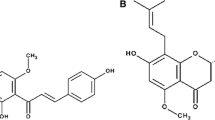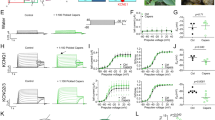Abstract
The influence of a prenylated flavonoid—6-prenylnaringenin (6-PR) and selected non-prenylated flavonoids: acacetin, chrysin, baicalein, wogonin, and luteolin on the activity of voltage-gated potassium channels Kv1.3 was investigated in human leukemic Jurkat T cells. Electrophysiological measurements were accompanied by studies on the cytotoxic effect of the examined compounds on Jurkat T cells. Electrophysiological studies were performed using the whole-cell patch-clamp technique. Cell viability was determined using the MTT assay. 6-PR inhibited Kv1.3 channels in Jurkat T cells in a concentration-dependent manner. The estimated value of the half-blocking concentration (EC50) was about 5.76 µM. Among non-prenylated flavonoids, acacetin and chrysin inhibited Kv1.3 channels in Jurkat T cells when applied at the concentration of 30 µM, whereas baicalein, wogonin, and luteolin were ineffective at this concentration. The inhibitory effects of acacetin and chrysin on Kv1.3 channels were significantly less potent than the inhibition caused by 6-PR. All tested compounds inhibited growth of Jurkat T cells in a concentration-dependent manner. Wogonin and chrysin were the most cytotoxic flavonoids tested, whereas baicalein and 6-PR were the least cytotoxic compounds. In accordance to our hypothesis the prenylated flavonoid (6-PR) was much more effective inhibitor of Kv1.3 channels than non-prenylated compounds selected for this study. The inhibition of Kv1.3 channels by 6-PR, acacetin, and chrysin was not related to cytotoxicity of these compounds. The channels’ inhibition might be involved in anti-proliferative and pro-apoptotic effects of 6-PR, acacetin and chrysin observed in cancer cell lines expressing these channels.









Similar content being viewed by others
References
Araujo J, Goncalves P, Martel F (2011) Chemopreventive effect of dietary polyphenols in colorectal cancer cell lines. Nutr Res 31:77–87
Chen P, Zhang J, Sha B et al (2017) Luteolin inhibits cell proliferation and induced cell apoptosis via down-regulation of mitochondrial membrane potential in esophageal carcinoma cells EC1 and KYSE450. Oncotarget 8(16):27471–27480
Delmulle L, Vanden Berghe T, de Keukeleire D, Vandenabeele P (2008) Treatment of PC-3 and DU145 prostate cancer cells by prenylflavonoids from hop (Humulus lupulus) induces a caspase-independent form of cell death. Phytother Res 22:197–203
Delmulle L, Bellahcene A, Dhooge W et al (2006) Anti-proliferative properties of prenylated flavonoids from hops (Humulus lupulus) in human prostate cancer cell lines. Phytomedicine 13:732–734
Felipe A, Vincente R, Villalonga N et al (2006) Potassium channels: new targets in cancer therapy. Cancer Detect Prev 30:375–385
Gąsiorowska J, Teisseyre A, Uryga A, Michalak K (2012) The influence of 8-prenylnaringenin on the activity of voltage-gated Kv1.3 potassium channels in human Jurkat T cells. Cell Mol Biol Lett 17:559–570
Gąsiorowska J, Teisseyre A, Uryga A, Michalak K (2015) Inhibition of Kv1.3 channels in human Jurkat T cells by xanthohumol and isoxanthohumol. J Membr Biol 248:705–711
Grissmer S, Lewis R, Cahalan M (1992) Ca2+-activated K+ channels in human Leukemic T cells. J Gen Physiol 99:63–84
Grissmer S, Nguyen A, Cahalan M (1993) Calcium-activated potassium channels in resting and activated human T lymphocytes. J Gen Physiol 102:601–630
Gulbins E, Sassi N, Grassme H, Zoratti M, Szabo I (2010) Role of Kv1.3 mitochondrial potassium channels in apoptotic signaling in lymphocytes. Biochim Biophys Acta 1797:1251–1259
Guo Z, Hu X, Xing Z et al (2015) Baicalein inhibits prostate cell growth and metastasis via the caveolin-1/AKT/mTOR pathway. Mol Cell Biochem 406:111–119
Gutman G, Chandy K, Grissmer S, Lazdunski M, McKinnon D, Pardo L (2005) International union of pharmacology. LIII. Nomenclature and molecular relationships of voltage-gated potassium channels. Pharmacol Rev 67:473–508
Hamill O, Marty A, Neher E, Sakmann B, Sigworth F (1981) Improved patch-clamp techniques for high-resolution current recording from cells and cell-free membrane patches. Pfluegers Arch 39:85–100
Khoo B, Chua S, Balaram P (2010) Apoptotic effects of chrysin in human cancer cell lines. Int J Mol Sci 11:2188–2199
Kim E, Kang D, Han J (2011) Baicalein and Wogonin are activators of rat TREK-2 two-pore domain K + channel. Acta Physiol 202:185–192
Leanza L, Romio M, Becker K et al (2017) Direct pharmacological targeting of a mitochondrial ion channel selectively kills tumor cells in vivo. Cancer Cell 31:516–531
Li-Weber M (2009) New therapeutic aspects of flavones: the anticancer properties of Scutellaria and its main active constituents: wogonin, baicalein and baicailin. Cancer Treat Rev 35:57–68
Palko-Łabuz A, Środa-Pomianek K, Uryga A, Kostrzewa-Susłow E, Michalak K (2017) Anticancer activity of baicalein and luteolin studied in colorectal adenocarcinoma LoVo cells and in drug-resistant LoVo/Dx cells. Biomed Pharmacother 88:232–241
Perez-Garcia M, Cidad P, Lopez-Lopez J (2018) The secret life of ion channels: Kv1.3 potassium channels and proliferation. Am J Physiol Cell Physiol 314:C27–C42
Perez-Verdaguer M, Caspera J, Serrano-Novillo C, Estadella I, Sastre D, Felipe A (2016) The voltage-gated potassium channel Kv1.3 is a promising multitherapeutic target against human pathologies. Expert Opin Ther Targets 20(5):577–591
Ryu S, Lim W, Bazer FW, Song G (2017) Chrysin induces death of prostate cancer cells by inducing ROS and ER stress. J Cell Physiol. https://doi.org/10.1002/jcp.25861
Seelinger G, Merfort I, Wölfle U, Schempp Ch (2008) Anti-carcinogenic effects of the flavonoid luteolin. Molecules 13:2628–2651
Serrano-Albarras A, Estella I, Cirera-Rocosa S, Navarro-Perez M, Felipe A (2018) Kv1.3: a multifunctional channel with many pathological implications. Expert Opin Ther Targets 22(2):101–105
Shim H, Park J, Palk H, Nah S, Kim D, Han Y (2007) Acacetin-induced apoptosis of human breast cancer MCF-7 cells involves caspase cascade, mitochondria-mediated death signalling and SAPK/JNK1/2-c-Jun activation. Mol Cells 24(1):95–104
Szabo I, Bock J, Grassme H et al (2008) Mitochondrial potassium channel Kv1.3 mediates Bax-induced apoptosis in lymphocytes. PNAS 105:14861–14866
Teisseyre A, Duarte N, Ferreira M-J, Michalak K (2009) Influence of the multidrug transporter inhibitors on the activity of Kv1.3 voltage-gated potassium channels. J Physiol Pharmacol 60:69–76
Teisseyre A, Gąsiorowska J, Michalak K (2015) Voltage-gated potassium channels Kv1.3 – potentially new molecular target in cancer diagnostics and therapy. Adv Clin Exp Med 24(3):517–524
Teisseyre A, Michalak K (2003) The voltage-and time-dependent blocking effect of trifluoperazine on T lymphocyte Kv1.3 channels. Biochem Pharmacol 65:551–561
Teisseyre A, Mozrzymas J (2002) Inhibition of the activity of T lymphocyte Kv1.3 channels by extracellular zinc. Biochem Pharmacol 64:595–607
Tuorkey M (2016) Molecular targets of luteolin in cancer. Eur J Cancer Prev 25(1):65–76
Venturelli S, Burkard M, Biendl M, Lauer UM, Frank J, Busch C (2016) Prenylated chalcones and flavonoids for the prevention and treatment of cancer. Nutrition 32(11–12):1171–1178
Zaccagnino A, Manago A, Leanza L et al (2017) Tumor-reducing effect of the clinically used drug clofazimine in a SCID mouse model of pancreatic ductal adenocarcinoma. Oncotarget 8(24):38276–38293
Zhao N, Dong Q, Fu X et al (2014) Acacetin blocks Kv1.3 channels and inhibits human T cell activation. Cell Physiol Biochem 34:1359–1372
Acknowledgements
The Authors want to express best thanks to Mr Przemysław Gogolewski from the Department of Biophysics, Wrocław Medical University for technical help in data analysis. This work was supported by the Polish Ministry of Research and University Education funds for Wrocław Medical University (Działalność statutowa).
Author information
Authors and Affiliations
Corresponding author
Ethics declarations
Conflict of interest
The authors declare no conflict of interest.
Rights and permissions
About this article
Cite this article
Teisseyre, A., Palko-Labuz, A., Uryga, A. et al. The Influence of 6-Prenylnaringenin and Selected Non-prenylated Flavonoids on the Activity of Kv1.3 Channels in Human Jurkat T Cells. J Membrane Biol 251, 695–704 (2018). https://doi.org/10.1007/s00232-018-0046-7
Received:
Accepted:
Published:
Issue Date:
DOI: https://doi.org/10.1007/s00232-018-0046-7




